Affiliate disclosure: This post may contain affiliate links. Please see our Privacy Policy.
Fire cider is a herbal remedy great for healing colds and the flu.
Learn how to use the healing power of common ingredients and make your fire cider today!
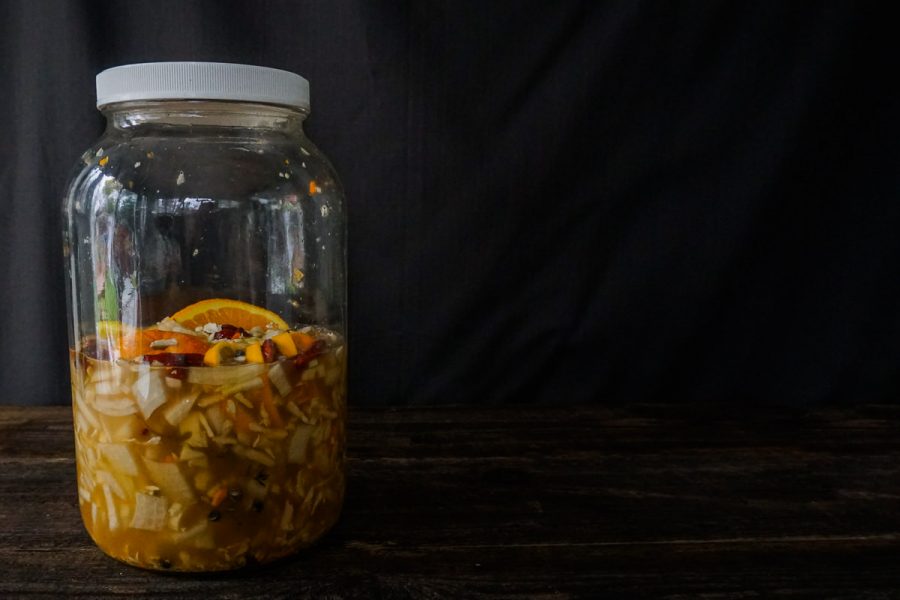
(This post was contributed by Melissa Keyser.)
Have you ever had fire cider?
If not, you’ll want to pull up a chair and take note. You need some of this magic potion in your kitchen.
When you’re sick, with snot dripping from your nose and a burning throat and an aching back and core, the last thing you might want to do is drink a shot of vinegar, right? But you should, because it’s super good for you and will curb that cold.
Not tempting enough? How about vinegar flavored with horseradish, onions, and garlic?
Awful sounding, I know. It’s a hard sell. But a few weeks ago, I caught the head cold that was going around, but thankfully, it was short lived.
I hold the success for kicking it to be taking regular doses of homemade fire cider. And, it actually tastes quite nice!
I’m not a clinical herbalist, but self-taught from books. One day I hope to go to herb school, but until then, I like to play around with preparations and herbs I feel comfortable with.
Making fire cider is one of them. If you’ve never made an herbal medicine, this is a great one to start with. It requires no fancy equipment, and it’s made with common ingredients from the garden, the pantry or the grocery store.
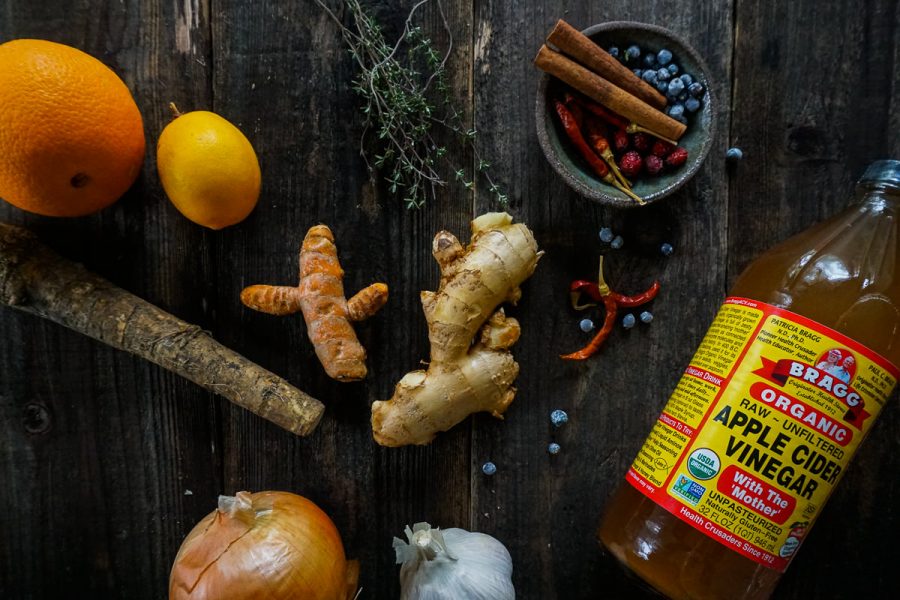
What is fire cider?
Fire cider is an herbal remedy to take at the first signs of a cold or flu.
This is traditional medicine, also known as a folk remedy, and has been called “the most powerful antibiotic ever” (at least, according to the internet). The ingredients can change from year to year, depending on the season it’s being prepared and what’s growing around you.
I love making fire cider because not only does it help keep me healthy, but it allows me to channel my inner kitchen witch. My goal is to be an old woman, with long silver hair, living in a cabin in the woods.
Dried herbs will be hanging from the rafters, lines of jars and bins fill the panty, a cat (or two. or three) in front of a woodstove, and I’ll be at a well-worn kitchen table, preparing herbal medicines. Perhaps I’ve read too many fairy tales?
I’m not at that stage of my life, but there are elements I can channel now. I can have the bundles of drying herbs, prepare the herbal medicines, and I already have the cats, albeit sitting in front of a space heater.
While I have no idea if fire cider was part of my ancestor’s repertoire, I’m sure they created something similar- gathering ingredients from the earth and creating potions to help keep them well. As I make herbal medicine, I like to think of the women before me who walked their own lands, stood in their own kitchens, and used their hands to make the same medicines.
Too woo-woo for you? At the very least, I can avoid the psychedelic colored goo that comes in a plastic bottle at the drugstore and give a big middle finger to big Pharma.
How to Make your Own Fire Cider
There are many different versions of fire cider, each herbalist making their own adjustments, but the basics are all the same: fresh garlic, onions, ginger, horseradish, and chile peppers infuse vinegar for a desired amount of time, then the vinegar is strained and honey is added. There are also many other ingredients you can add, based on your herbal goals and what’s available to you.
Want to get started on your own batch? Skip to the bottom for the recipe. Want to know more about what’s in fire cider and why it works? Keep reading.
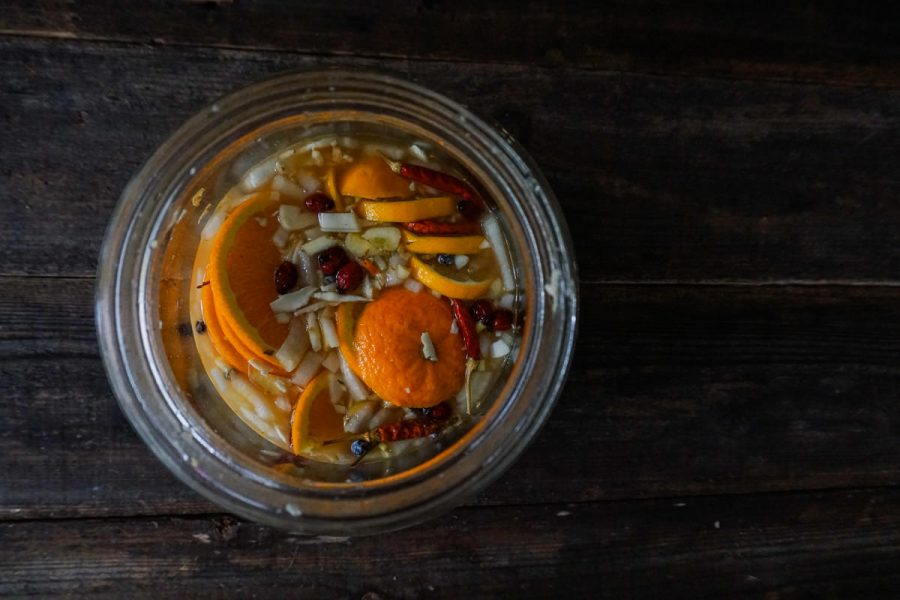
For your fire cider, you want to make sure to use raw, unpasteurized and unfiltered apple cider vinegar. This is the vinegar that has the weird brown silty stuff at the bottom, also known as the mother. Bragg’s is a common brand, but there are others out there.
The vinegar pulls out the important healing properties of the foods, but it could also pull out any poison residues. Avoid that, and make sure to use organic ingredients for your homemade medicines.
Fire Cider Ingredients
Apple Cider Vinegar is valuable for cold and flu care as it can soothe sore throats, helps with digestion issues, thins mucus and reduces congestion (so that runny nose or a cough), boosts energy, and can kill free radicals.
Ginger is a warming and decongesting herb, and is anti-inflammatory, anti-bacterial, and anti-viral. Ginger helps with imbalances such as poor circulation, colds, and bouts of the flu. It has been shown to reduce inflammation and is effective for nausea and gastrointestinal infections.
Horseradish is a potent infection fighter. Ounce for ounce, horseradish has more medicinally active compounds than any other spice.
It is useful for treating upper respiratory problems, reducing inflammation, fights bacteria and viruses and helps relax muscles. Like the vinegar, it also helps clear congestion and thins mucus. Yummy, right?
Onion can help lower cholesterol, regulate blood sugar, and kill cancer cells. They are anti-inflammatory and can help relax the airway muscles and asthma systems. Onions are rich in antioxidants, which protect the body against free radicals, which encourage a strong immune system.
Garlic is one of the most versatile culinary herbs for treating colds, the flu, sore throats and poor digestion. It boosts the body’s immune systems and is antiseptic, anti-bacterial, and anti-microbial; making it effective against many types of infections, even those found to be from antibiotic-resistant strains of bacteria.
Chili gets its healing powers from its main constituent Capsaicin. It stimulates circulation, digestion, and signals the brain to release endorphins. It can aid and support the immune system, relieves congestion, and are anti-parasitic.
Citrus is a vitamin C powerhouse. It also tastes good.
Honey is loaded with anti-bacterial and anti-fungal properties. It can help suppress coughs and helps with sleep. It adds a balancing sweetness to the other pungent ingredients. Basically, making it drinkable.
My batch of Fire Cider:
I make a batch every year or so, changing it up a bit to try new things and use what I have around me. This batch, I used all the traditional ingredients, as well as adding some thyme from the garden, cinnamon sticks, and foraged rose hips and juniper berries.

Fire Cider
Ingredients
- 1/2 cup freshly grated ginger root, peeled or not
- 1/2 cup freshly grated horseradish root, peeled
- 1 medium onion, chopped
- 10 cloves garlic, chopped
- 2 spicy peppers, chopped if fresh (such as jalapeno or cayenne)
- 1 lemon, sliced or chopped
- 1- quart raw apple cider vinegar
- 1/4 cup, or more, local raw honey
Optional Ingredients
- Orange, Lime, Grapefruit, Rosemary, Thyme, Oregano, Fresh Turmeric, Rosehips, Juniper berries, Star Anise, Schisandra berries, Astragalus, Parsley, Burdock, Echinacea, Peppercorns, Cinnamon, Yarrow, and/or Elderberry
Instructions
- Place all prepared ingredients in a large glass jar. Cover with the apple cider vinegar.
- Close the jar. If using a metal lid, put a piece of parchement between the glass and the lid, to keep the vinegar from touching the metal.
- Set aside in a dark spot, shaking daily (or as remembered).
- Let steep for 3-4 weeks, then use cheesecloth or a fine sieve to strain.
- Add honey to vinegar and stir until incorporated. Taste and add more if needed.
Notes
Disclaimer: I am not a medical professional and the information I provide is not intended to be a substitute for medical treatment.
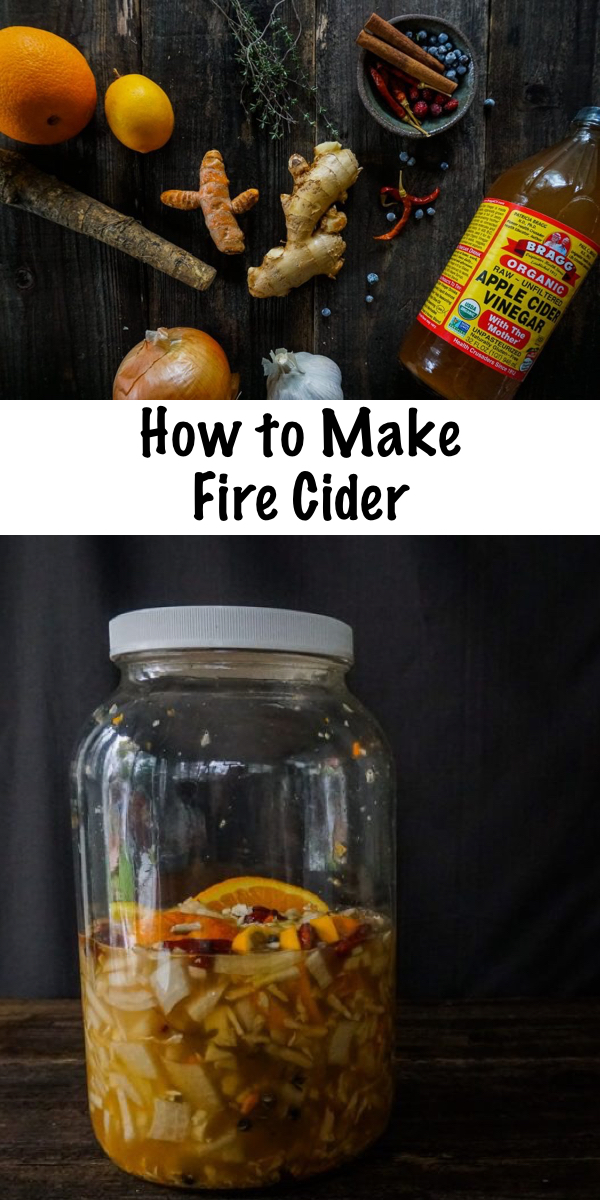
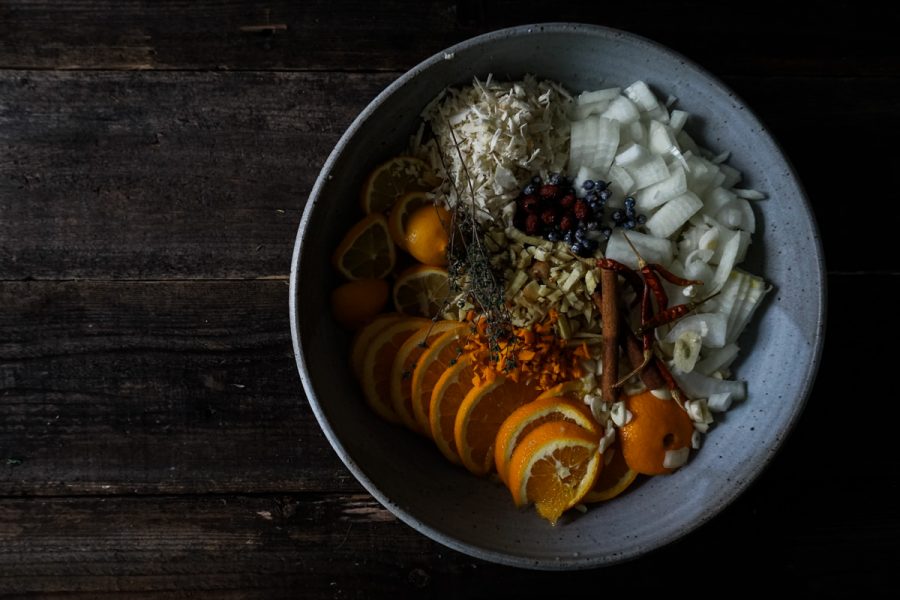


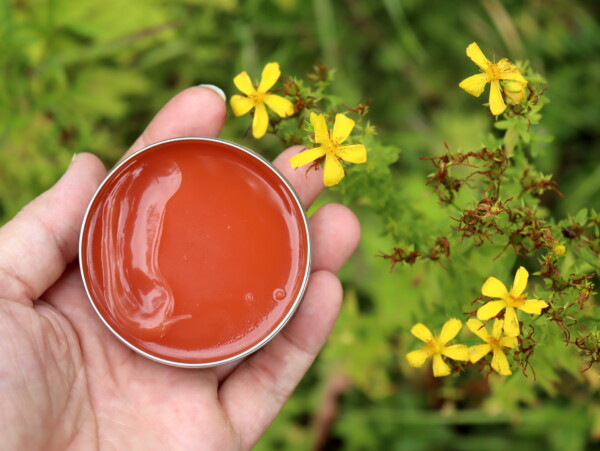
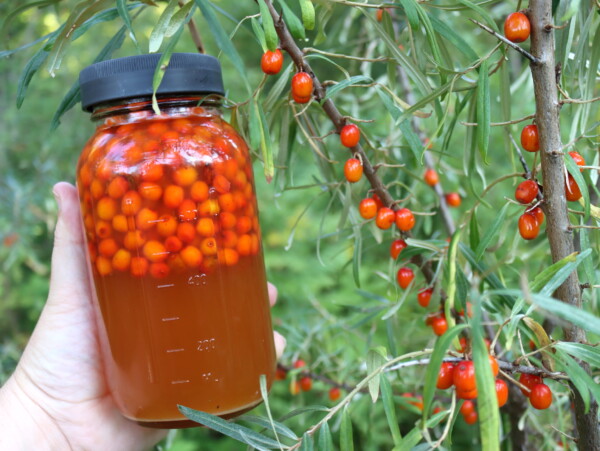










Hi,
Thanks for the article!
Regarding the citrus (lemon), is the recipe to add the whole lemon, meaning skin and all (chopped up) ?
Look forward to your reply.
Blessings
Yes, that’s correct. There is a lot of good stuff in the peel.
Hi there! I just made my first batch of fire cider about 8 weeks ago and I’m ready to strain it. I used the Braggs brand ACV, but I’m still nervous about the cloudiness and sharp smell when I open the jars. I made 3 quart size jars and I hate to waste any. I know it’s “fire” cider and made with vinegar, and it’s going to smell strong and sharp, but I’m trying to not second guess myself! What indicators do I need to know that it’s still good, visually and smell wise? I have no home base for what “looks good and smells good.” Thank you so much for your time and reply, and all your information you share!
If you used an apple cider vinegar with the mother like Bragg’s It will definitely have a cloudiness to it. It should smell like vinegar with a kick. The only concern would be mold. As long as there isn’t mold on the surface, then it should be fine. Vinegar is very shelf stable.
Hello from East Texas! I added jalapeno and pineapple in to my fire cider recipe. Exited to try it out!
Hi, I accidentally forgot about my fire cider for over a year. Is it still ok to strain and use? It has not been refrigerated. thanks for your help!
If it looks and smells ok, it should be fine.
I forgot my fire cider for about a year. Is it still safe to use? Thanks for your help!
As long as it looks and smells good, it should be just fine.
Dear Ashley, I must tell you that I love your writing 🙂
Like you, I now live on the countryside and I also play around with all the medicine herbs that grow wildly in my small bout of land. I share your dream of a old lady living in a cabin in the woods,.. I already have the cats and a lot of herbal medicine jars sitting in my pantry. An I am old, too 🙂
Thanks a lot for this post, I had never heard of this medicine before, I think it is not used in my country (Portugal), and for sure I will give it a try..
Thanks again for all the good inspiration and good laughs in your posts.
Best wishes,
Ana
You’re so very welcome. Thank you so much for your lovely comments.
How much turmeric and peppercorns do you recommend?
You can start off with about 1 tsp of the peppercorns. If you’re using dried turmeric you can start off with the same amount or up to 2 oz. if it’s fresh.
Could pineapple or pineapple rind be added?
You could certainly try it. There are so many different ways to make fire cider. Let us know if you decide to try it.
I am interested in making this but have a question about the recipie – is the honey only added after the other ingredients in vinegar sit for the month? Or are you saying to add *more* honey at that time?
You want to add all of the ingredients except for the honey to the vinegar for the infusion. Once the infusion is finished then you will strain it and add the honey.
I started my fire cider two months ago, and I am about to strain it. Have I left it too long?
I have left mine before. It should be just fine.
Thank you, so much for all your informative posts! I always like to see different variations of the fire cider recipe, depending on the person/geographic area. I visit your site often, as we seem to have lots in common. My family lived on a farm for many years & we are now focused on foraging & perennial permaculture while homeschooling…lol. As a pharmacist/herbalist, I appreciate your detailed, informative posts! Keep up the good work & feel free to reach out-I’m always in the market to trade goods & info!
You’re very welcome. I am so glad that you are enjoying the posts.
Finally made my first batch! My question is what do you do with the pulp? I’d love to use it for a broth but I am not sure how long it will keep once I’ve strained it. Can I save it in a sealed container in the freezer? Or do I need to dehydrate the pulp to save it?
If you are wanting to save the pulp, freezing or dehydrating will work.
Your blog is awesome I have done and learned so much from you.
The honey really cuts down on the acid. So I suggest to wait for full fermentation then add your honey. I myself have acid reflux after adding honey I have no problems with this recipe. I keep I cool dark cabinet. Never seems to go bad I just keep making more as I nee it..
Love learning more n more !! Happy trails to you all!!!
Do you suppose this could be water bath canned for longer/better storage?
I imagine it could, following the instructions for water bath canning pickles. Assuming you strain everything though, there’s really no reason infused vinegar should go bad. Part of the goodness of the recipe comes from raw vinegar and it’s probiotics, and that’d be removed in the canning process as everything is pasteurized.
Hi. Love this and thanks. Only problem, I can feel it burning my throat when I swallow my fire cider and my throat actually now feels very sore. I’ve read where people say ACV shouldn’t be taken straight or it could destroy your oesophagus. I’m very worried. (1) Isn’t this taking it straight? (2) I started taking it after only one week of fermentation cos I couldn’t wait. Could fermenting it longer have made the ACV milder? (3) Any tips for me? Maybe a spoon of yoghurt right after taking it, could that help? (4)
Thanks already.
It really depends on your sensitivity to both acid and spice. Personally, I don’t have a problem drinking ACV, but everyone is different. Garlic and horseradish can be pretty harsh though and depending on how strong the particular plant is, those can sometimes cause irritation for me. If you’re having issues with it (but you still want to keep trying it) I’d suggest diluting it in water before drinking it, or making it into a switchel type drink by adding both water and honey in the glass.
Listen to your body though, don’t do anything that causes irritation or hurts your throat. It’s always possible that you’re having a reaction to something, or it’s just not right for you.